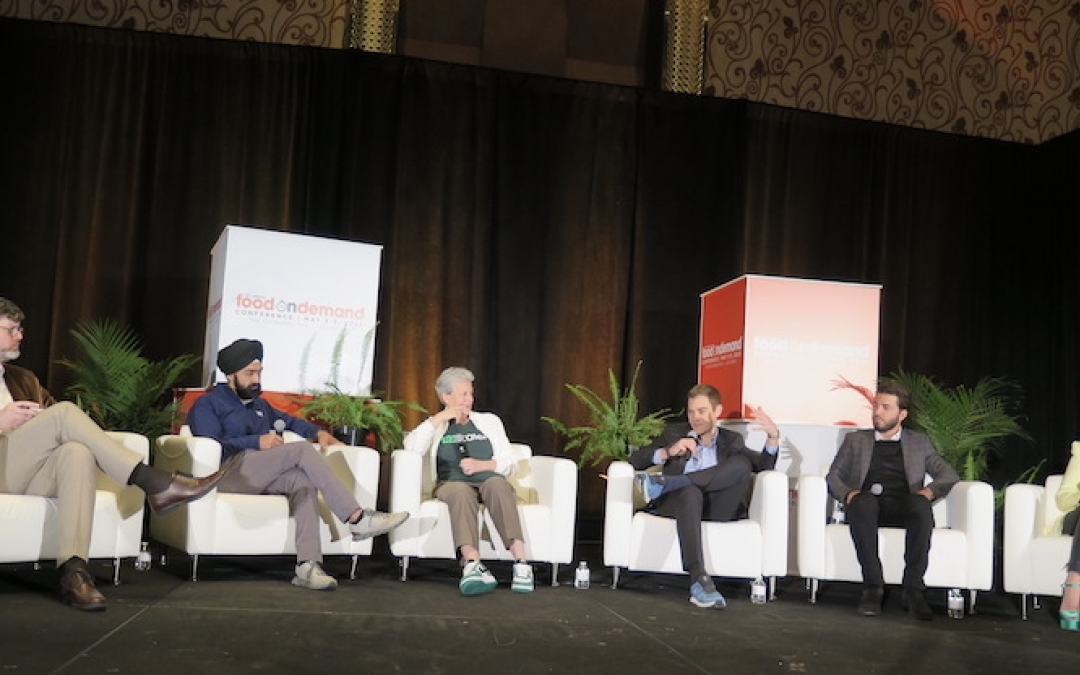Editor Tom Kaiser posed the million-dollar question to panelists to open the Food On Demand Conference today: “We are not in an official recession but inflation is clearly having a huge impact on restaurants, and bringing the cost of delivery to unbelievable heights. Why have we not seen delivery volumes falling back to Earth?” he asked.
“We have not seen anything falling back to Earth,” said Stefania Mallett, with ezCater, which like others had a near-death experience when the pandemic torpedoed 85 percent of its business. “In 2021 we had come back 100 percent from where we were before COVID. In 2022 we grew 87 percent from 2021. This year we’re growing at a similar clip.”
Her thesis: “There are so many cases for food at work that are business-critical. They are not a perk. If you have a training event, they expect breakfast, lunch. The employee lunches, what used to be a perk is no longer a perk in many industries. God bless the Gen Z people. ‘What do you mean you’re not going to feed me?’ I love these people,” she said.
“And in the hybrid scenarios, which apply to 40 to 50 percent of the workers, food is a huge” incentive to get people in. “There are a lot of business reasons why you can’t afford to not have food in your workplace.”
Noah Glass, CEO and founder of Olo, spoke from the consumer perspective. “It feels like delivery is kind of a way of life. It’s the ultimate convenience. It’s just magically coming to you,” he said, noting his company is nearing its 18-year anniversary. Maybe consumers are ordering from a lower-cost restaurant, or ordering less food to deal with inflation. “But I think delivery is the last thing to go, not the first thing to go.”
Stephanie Sollers, CEO of Virtual Dining Concepts, agreed. “We’ve created a new behavior, a new category, a new habit. The idea that we would shy away from delivery is not even an option. Getting your food on demand at your home when it’s convenient for you from the best channel, everyone here is working to meet the customer where they are. I just don’t see it changing in any other way.”
Michael Montagano, CEO of Kitchen United, believes there’s still a long way to go to catch up to other countries. “We still sit at maybe 10 to 20 percent market penetration,” while other countries, especially in Asia, are 50 percent and more. “I still think there’s a lot of room for the market to be able to run in the U.S.”
Savneet Singh, CEO of PAR Technology, believes technology has a long way to go as well, and his company spends some $50 million on R&D every year. He says customers don’t ask PAR to spend more on artificial intelligence or robots or other cutting-edge items. Rather, their needs are prosaic.
“It’s make the shit work better now, and then talk to me about the future. Which is sad. A lot of what we’re spending on is to make it work better today. I don’t think we’ve delivered the promises of technology yet,” he said.
“In many ways technology is a wedge between the food and that experience. What we’re all trying to create is technology that enhances” the guest experience. “To me the key is how seamless an experience we can make. But the back-end execution still has to work,” he said.
“I feel like what we’ve done to restaurants: ‘Hey, you have to run this amazing experience in your store…and you have to run an Amazon.com warehouse out the back.’ And that’s hard. All of our industry’s goal is how do we support that. I think it’s balancing both the front-end digital experience, but then also the back end.”
The Food On Demand Conference continues through May 5 at the Cosmopolitan in Las Vegas.


